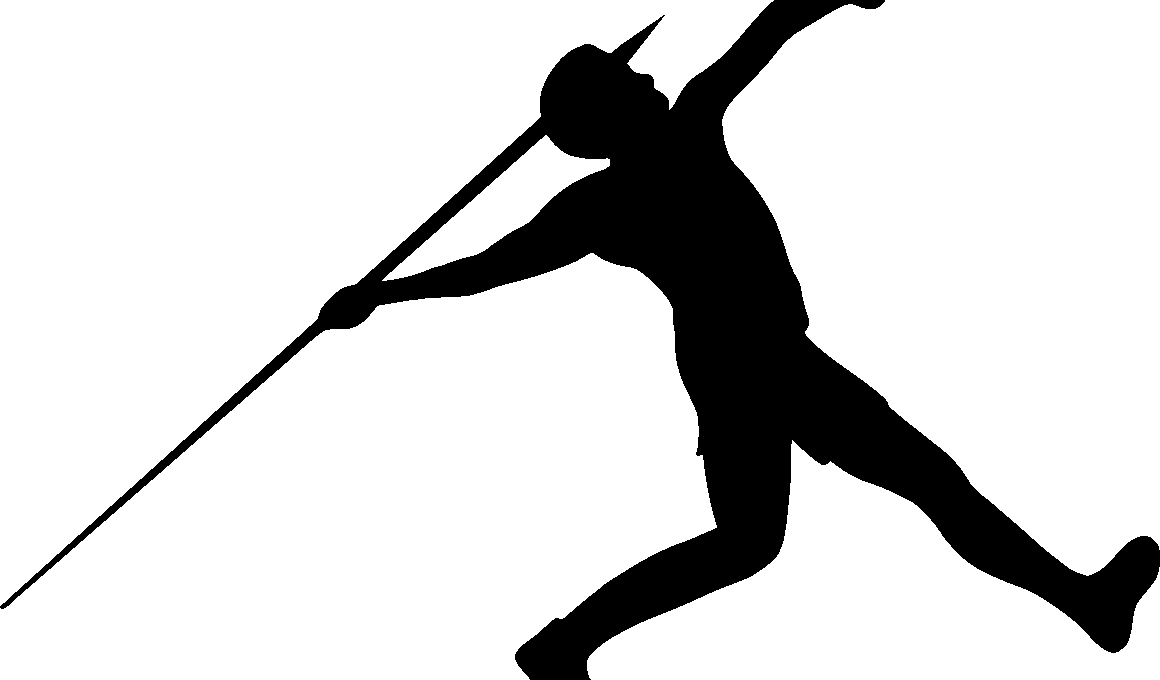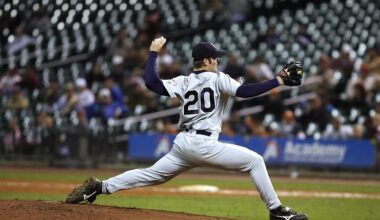The Biomechanics of Throwing Sports: Baseball and Javelin
Understanding the biomechanics of throwing sports aids athletes in achieving optimal performance. Both baseball and javelin are dynamic movements that require significant physical and technical skills. The mechanics of throwing involve complex interactions between muscular coordination and body posture. This complexity makes each sport unique in its demands. In baseball, the pitcher uses a windup, followed by a powerful throw towards home plate. Conversely, in javelin, athletes generate momentum through a running approach before launching. Coaches emphasize technique to optimize performance. Proper throwing mechanics can lead to increased speed and distance. The kinetic chain significantly influences a throw’s effectiveness, where energy is generated in a sequential manner. Enhancing muscle strength and flexibility is crucial for throwers in both sports. Substantial focus on arm angle, trunk rotation, and foot placement is vital to achieve efficient motion. Understanding the physics behind the throw, such as angles and forces, empowers athletes to maximize their potential. Biomechanical analysis tools, including high-speed cameras, help break down unique motion patterns. These insights are immensely beneficial for tailoring training regimens, allowing athletes to excel in their respective throwing disciplines.
In baseball, pitchers often take a specific approach to enhance their throwing technique. The act of pitching incorporates phases that are essential for success. The preparatory phase allows pitchers to leverage their entire body during the throw. Key components, including balance and coordination, play significant roles here. A stable position at the foot’s base can greatly impact the overall throw’s effectiveness. Consequently, pitchers are encouraged to maintain an upright posture to ensure proper alignment. The arm action initiates during the windup, progressing into the acceleration phase. It’s here that speed becomes critical; a quick arm motion generates force. Additionally, trunk rotation contributes rotational power. This aspect is prevalent in both baseball and javelin throwing. However, the javelin throw has a distinct technique involving a different sequential approach. As the athlete approaches, they build momentum, combining speed with a powerful finish. The final act of thrusting the javelin forward requires precise timing. In both sports, biomechanics emphasizes the ideal angles during release. Dynamic assessments offer an impressive insight into technique modifications and how adjustments yield performance metaphors in the field.
The Role of Strength and Conditioning in Throwing Techniques
Strength and conditioning are critical elements in optimizing performance within throwing sports. Both baseball and javelin demand specific muscle strength, flexibility, and endurance. Targeted strength training improves the effectiveness of the kinetic chain while reducing the risk of injury. A balanced training regimen encompasses various exercises, including resistance training and plyometrics. Implementing resistance exercises, such as squats and deadlifts, fortifies the lower body for robust movement. Strong legs provide a powerful base during the throwing motion. Furthermore, upper body workouts, including shoulder presses and rotator cuff exercises, ensure shoulder stability, enhancing throwing ability. Flexibility exercises remain essential for optimal range of motion. Stretching routines for the shoulders and legs alleviate potential strain during throws. Ultimately, a comprehensive conditioning program tailored for each athlete’s needs can significantly impact their performance. Drugs and supplements should be avoided to maximize natural strength. Periodized training programs adapt throughout the season according to performance objectives. Monitoring training loads helps ensure athletes aren’t overworked, allowing for recovery. This structured approach enables athletes to maintain peak performance levels, which is crucial during competitions. Coaches are pivotal in developing effective conditioning models for both sports.
Injuries in throwing sports can significantly impede an athlete’s career, particularly in baseball and javelin. The repetitive nature of throws can lead to overuse injuries among pitchers and javelin throwers. Common injuries include rotator cuff strains and elbow tendinitis, which necessitate immediate attention. Understanding the biomechanics of these movements helps design preventive strategies. Detailed movement analysis can reveal biomechanical flaws contributing to stress on specific joints. Regular assessments monitor changes in technique, allowing timely feedback and correction. Rehabilitation protocols should emphasize gradual re-introduction to throwing activities. Moreover, incorporating recovery routines aids in alleviating stress on overused areas. Early intervention is essential to avoid long-term implications. Collaboration between coaches, athletes, and physiotherapists creates effective training environments that prioritize injury prevention. Education on proper warm-ups and cooldowns facilitates muscle recovery. Athletes should engage in cross-training activities to prevent repetitive stress injuries. This approach enhances overall fitness without solely focusing on throwing. Furthermore, understanding the biomechanics involved offers insights into improving techniques. By adopting research-backed practices, athletes can maintain longevity in their careers and continue excelling in their sports.
Adapting Biomechanics for Youth Athletes
Training youth athletes in sports like baseball and javelin necessitates an understanding of biomechanical principles tailored to their developmental stages. Youth throwing athletes require specific attention as their bodies undergo significant changes. Coaches must ensure that young throwers do not overexert themselves. Implementing age-appropriate techniques is crucial for their physical development. Emphasis should lie on developing strong fundamentals without pushing them towards performance metrics too soon. Good mechanics are essential for preventing injuries while encouraging sustainable growth. Athletes should engage in fun and informative drills that create positive experiences around throwing. Exploring the mechanics behind each throw through simplified explanations can elevate understanding. However, it’s important that children learn the joy of throwing before focusing on precision. Allowing for creativity in technique fosters better engagement. Regular evaluations assist coaches in monitoring skill development over time, ensuring athletes progress appropriately. Promoting teamwork and social interaction among peers builds confidence in youth athletes. Supporting mental and physical aspects emerges as a key component. Programs must adapt to the evolving needs of young athletes without sacrificing enjoyment in the sport. By nurturing foundational skills today, better throwers will emerge in the future.
Advancements in technology have made a significant impact in studying throwing sports like baseball and javelin. Biomechanical analysis tools have become increasingly sophisticated, enabling precise measurements of technique. High-speed cameras and motion capture systems allow analysts to decode the intricate mechanics of each throw. Data analytics help quantify performance aspects, establishing standards for excellence. Coaches can track an athlete’s progress through video feedback, driving improvements in technique. Performance analysis software further enhances this by breaking down movements into digestible components, highlighting areas for enhancement. These insights are particularly beneficial for both novice and elite athletes. Moreover, athletes can visualize their movements and understand areas needing change. Integrating technology into coaching carries various advantages. Athletes can access valuable information on angles, velocities, and force alignments from analysis. Coaches develop informed strategies for improving performance based on this data. Integration of biomechanics into training leads to more informed decisions about technique adjustments. Increased accuracy leads to reduced injury rates and improved long-term outcomes. Utilizing the latest technology fosters creativity and innovation in the realm of sports training, transforming how athletes approach their sport, especially in throwing.
Conclusion: The Future of Throwing Sports Biomechanics
As the understanding of biomechanics in throwing sports continues to evolve, athletes benefit from enhanced training methodologies. The journey toward optimizing performance demands a multifaceted approach, integrating physical training, technical execution, and the latest technological innovations. Future advancements are likely to continue redefining how baseball and javelin are coached, emphasizing injury prevention and performance optimization. Increasingly, biomechanical knowledge will be shared openly among athletes and coaches alike. Integrating best practices with cutting-edge technological tools will become essential for future success. The focus will shift from merely competitive achievement to overall athlete well-being. High emphasis will be placed on long-term athlete development strategies. As biomechanical insights become more accessible, monitoring and improving technique will be simplified for all levels. Optimizing training will require continual adaptation as the sports landscape changes. Mentorship programs connecting experienced athletes with upcoming talents will foster knowledge transfer within the community. Engaging in resource-sharing can benefit everyone involved. Ultimately, understanding the underlying biomechanical principles will help simplify understanding performance. This collective endeavor will propel both baseball and javelin forward, keeping pace with the ever-changing environment of competitive sports.
This article explores the intricate mechanics of throwing in sports such as baseball and javelin. Each sport requires specific biomechanical insights to understand how athletes excel in their throwing techniques. A strong grasp of biomechanics enhances performance outcomes by reducing the risk of injuries and improving training efficacy. Athletes at various levels can reap the benefits of research-backed approaches to optimize their technique. By utilizing technology and focusing on strength conditioning, throwers can adopt methods that allow for increased distance and speed. Understanding the mechanics involved empowers athletes to make informed changes that enhance their throwing abilities. Take advantage of the supporting role of coaches in this education to ensure proper techniques are taught. This holistic approach promotes athlete longevity in sports. Utilizing video feedback and analytics creates a tailored experience for understanding individual mechanics. Stretching and conditioning programs must be implemented strategically to reflect the nature of each sport. The application of biomechanical principles in training methods creates a foundation by which young athletes can flourish. Continuous development in coach education will ultimately shape the trajectory of both baseball and javelin training practices.


